Key takeaways
- French architecture showcases a variety of styles, from Gothic to modern, reflecting the country’s rich cultural history.
- Photography is essential in architecture as it captures the stories and emotions of buildings, allowing viewers to connect with their beauty.
- Key techniques in architectural photography include utilizing perspective, lighting, and context to create compelling narratives.
- Challenges in photographing architecture include balancing light and shadow, managing crowds, and capturing the scale and essence of structures.
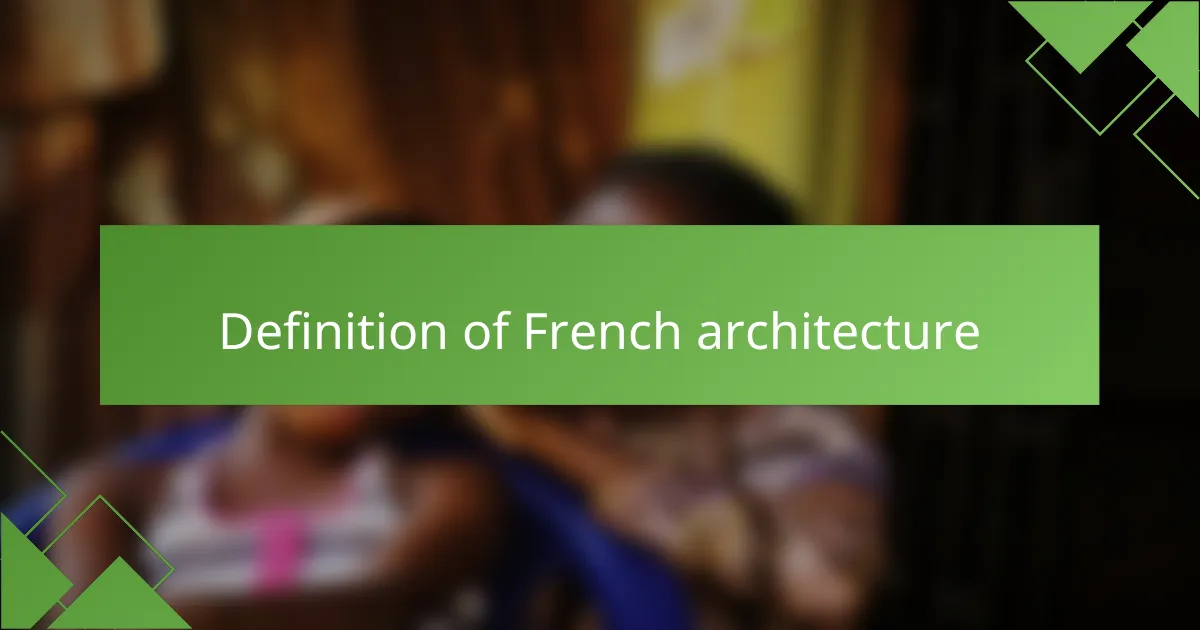
Definition of French architecture
French architecture is a rich tapestry woven through centuries, blending different styles from Gothic cathedrals to modern structures. Each era tells a story, revealing the cultural shifts and historical milestones that shaped France. I often find myself captivated by how the elegance of a bygone era seems to echo through the details of a contemporary building.
When I photographed the intricate facades of Parisian buildings, I was struck by their unique characteristics. Every curve, arch, and ornament resonated with history, creating an emotional connection that went beyond the surface. Capturing these elements through my lens felt like preserving snippets of time, allowing me to share the beauty of French architecture with others.
- Gothic cathedrals, like Notre-Dame, showcase pointed arches and ribbed vaults.
- Renaissance structures emphasize symmetry and proportion, evident in the Louvre.
- Baroque architecture, seen in Versailles, features grandeur and dramatic elements.
- Modernist designs embrace minimalism and function, influencing cities like Marseille.
- Eclectic styles embody a mix of influences, reflecting France’s diverse cultural heritage.
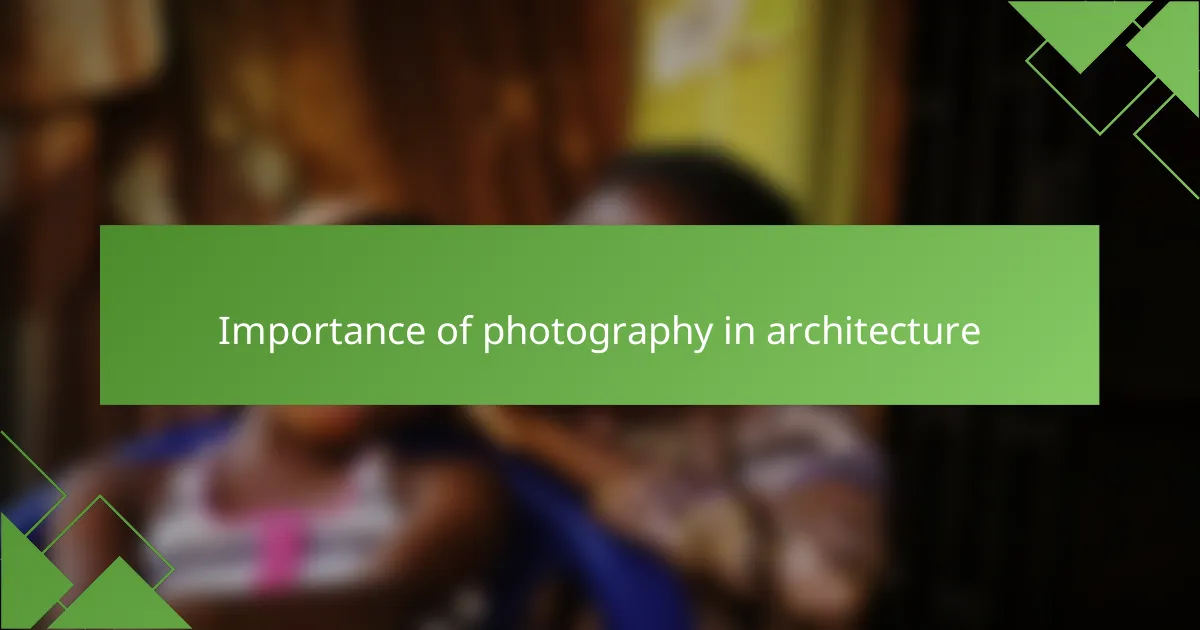
Importance of photography in architecture
Photography plays a crucial role in architecture, as it captures not just buildings but the stories they tell. Each photograph has the power to immortalize the essence of a structure, preserving its beauty and intricacies for future generations. When I stand before a magnificent Gothic cathedral, I often wonder: how can I best convey its grandeur and the emotion it evokes? The right angle or lighting can transform a simple shot into a breathtaking experience.
During my time photographing French architecture, I’ve realized that a well-composed image can tell a powerful narrative. For instance, the facade of a Renaissance building isn’t just a collection of bricks; it speaks volumes about the artistry and intent behind its design. I strive to capture these nuances, allowing the visual dialogue between the viewer and the building to flourish.
Moreover, photography serves as a bridge between the past and the present. When I edit my photos, I think about how each image connects with the viewer’s imagination and emotions. It’s incredible to feel that I can share not only what I see but what I feel in those moments. Isn’t it fascinating how a single photograph can inspire curiosity and admiration for the architectural achievements of France?
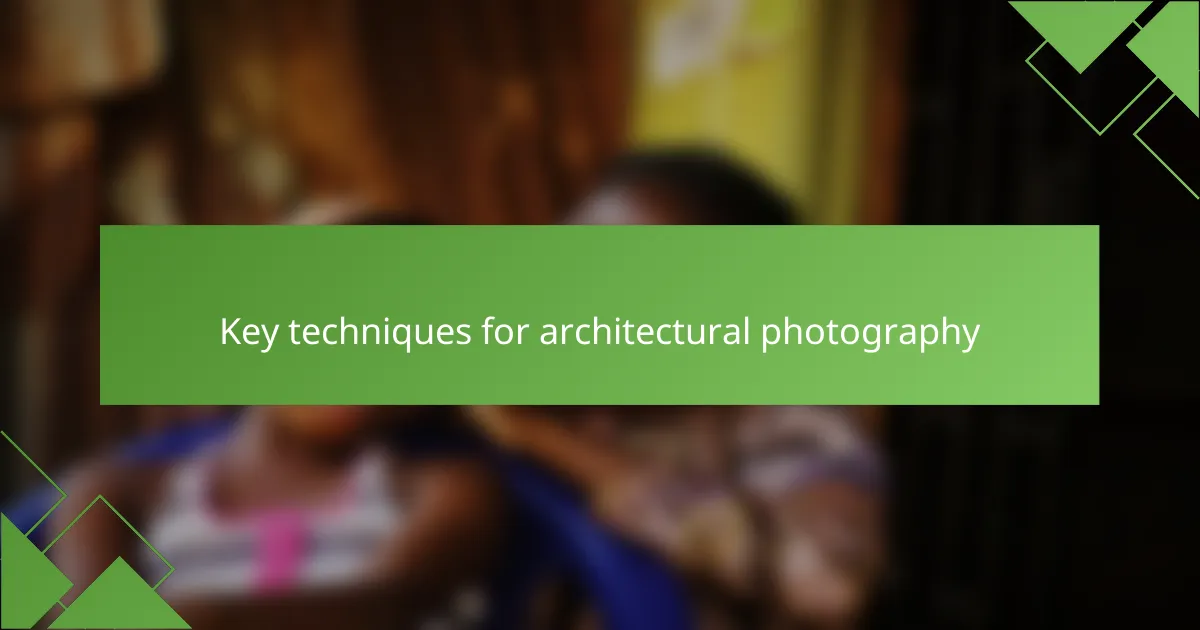
Key techniques for architectural photography
One of the essential techniques I embrace in architectural photography is the use of perspective. When I photograph a structure, I often experiment with different angles to convey a sense of depth and scale. For instance, capturing the soaring spires of a Gothic cathedral from below can evoke a feeling of awe. Have you ever looked up at a building and felt its presence towering above you? That sensation can be replicated in a photograph by carefully choosing your position.
Lighting also plays a pivotal role in my work. I’ve learned that golden hour—the time shortly after sunrise or before sunset—can accentuate textures and details that might otherwise be overlooked. I remember capturing the sun illuminating the ornate details of a Baroque palace; the play of light truly transformed my images. It made me wonder: how many elements of beauty are hidden in shadows, waiting to be revealed?
Finally, I can’t emphasize enough the importance of context in framing a shot. I often consider the surrounding environment when photographing iconic buildings. For example, a modernist structure in a bustling urban setting can tell a different story when juxtaposed with historic architecture. This interplay creates a rich narrative that resonates with the viewer. What emotions does this contrast invoke in you as you observe the harmony or dissonance between old and new? It’s these moments that make architectural photography so rewarding for me.
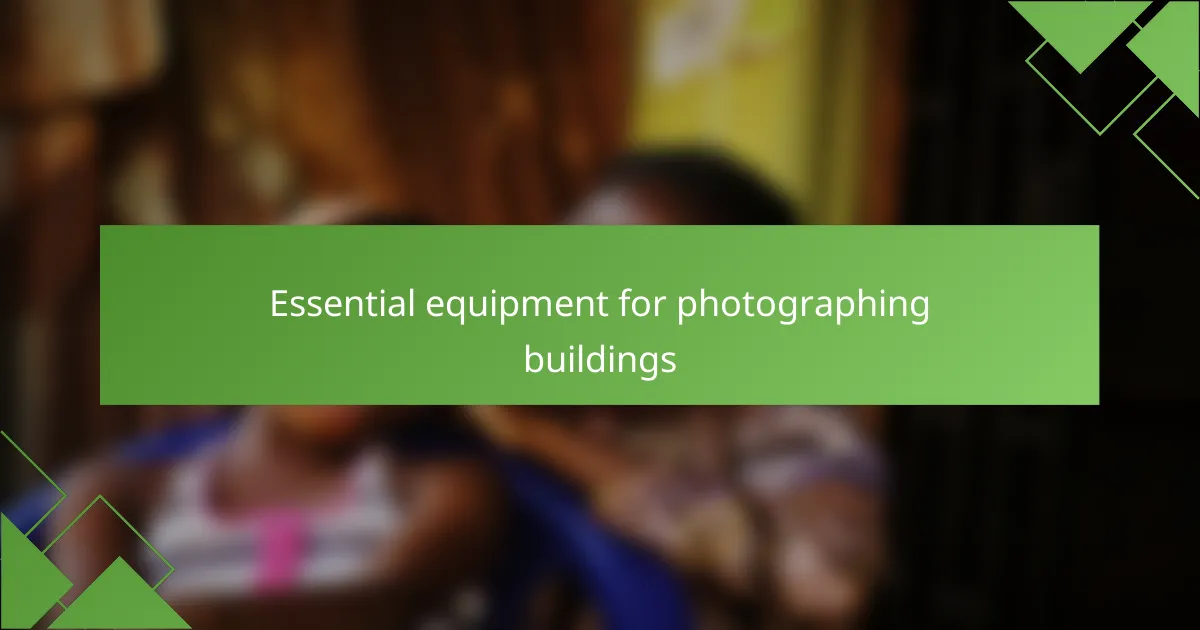
Essential equipment for photographing buildings
When capturing the elegance of French architecture, having the right equipment is paramount. On my first trip to Paris, I quickly learned that a sturdy tripod is essential for nighttime shots, especially when photographing iconic structures like the Eiffel Tower illuminated at dusk. The stability it provides allows for longer exposures that capture the soft, glowing lights beautifully.
Another indispensable item in my kit is a wide-angle lens. It enables me to encompass the grandeur of expansive buildings and intricate facades in a single frame. I vividly recall standing beneath the majestic arches of the Palais Garnier, feeling dwarfed yet enchanted by the architecture. That wide-angle lens allowed me to capture not just the building, but also the atmosphere.
Essential Equipment for Photographing Buildings:
– DSLR or Mirrorless Camera: Provides high-quality images and flexibility with interchangeable lenses.
– Wide-Angle Lens: Ideal for capturing large structures and close-quarter shots.
– Tripod: Essential for stability during low-light conditions and long exposures.
– Polarizing Filter: Helps reduce glare and enhance colors, bringing out the beauty of building details.
– Remote Shutter Release: Minimizes camera shake when taking long exposures, ensuring sharp images.
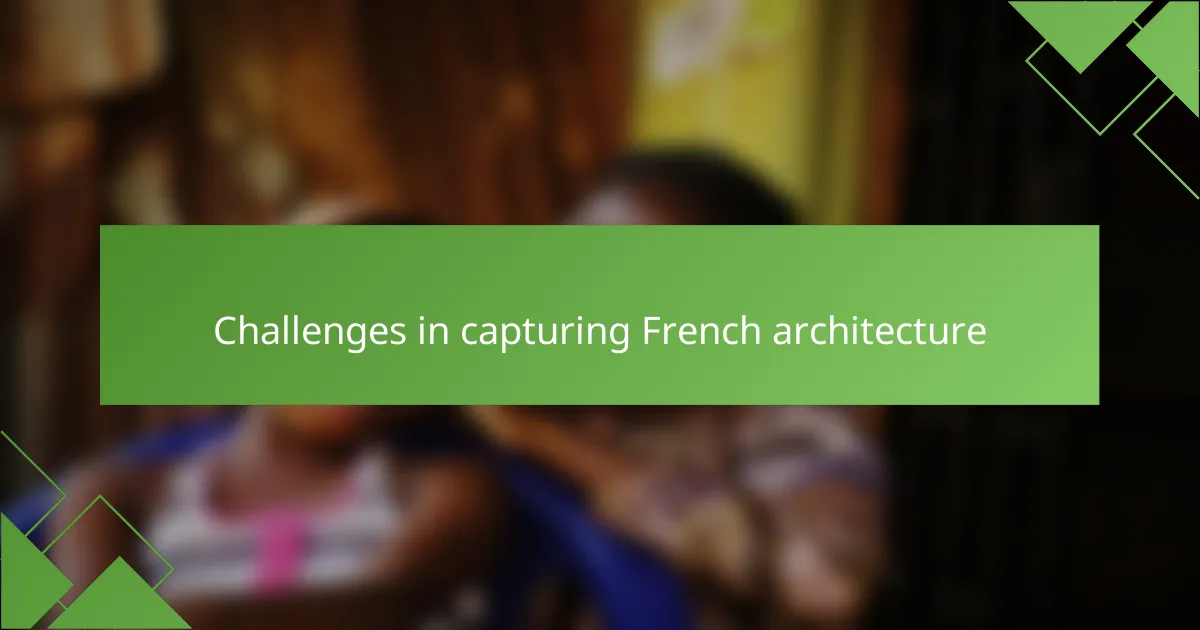
Challenges in capturing French architecture
Photographing French architecture certainly comes with its unique set of challenges. One time, while trying to capture the stunning intricate details of the Palais Garnier in Paris, I found myself wrestling with the sheer size and grandeur of the building. The scale can be overwhelming, and it’s easy to lose sight of the specific elements that make it beautiful.
Lighting is another hurdle I often face. During a golden hour shoot at the iconic Mont Saint-Michel, the shifting light created dramatic shadows that both enhanced and complicated the shot. I had to adjust my angles repeatedly to get that perfect blend of illumination and detail. Here are some common challenges I encountered:
- Balancing light and shadow to highlight architectural details
- Managing crowds around popular landmarks
- Finding the right angles to showcase grandeur
- Dealing with varying weather conditions that affect visibility
- Capturing the essence of historical buildings while maintaining modern aesthetics
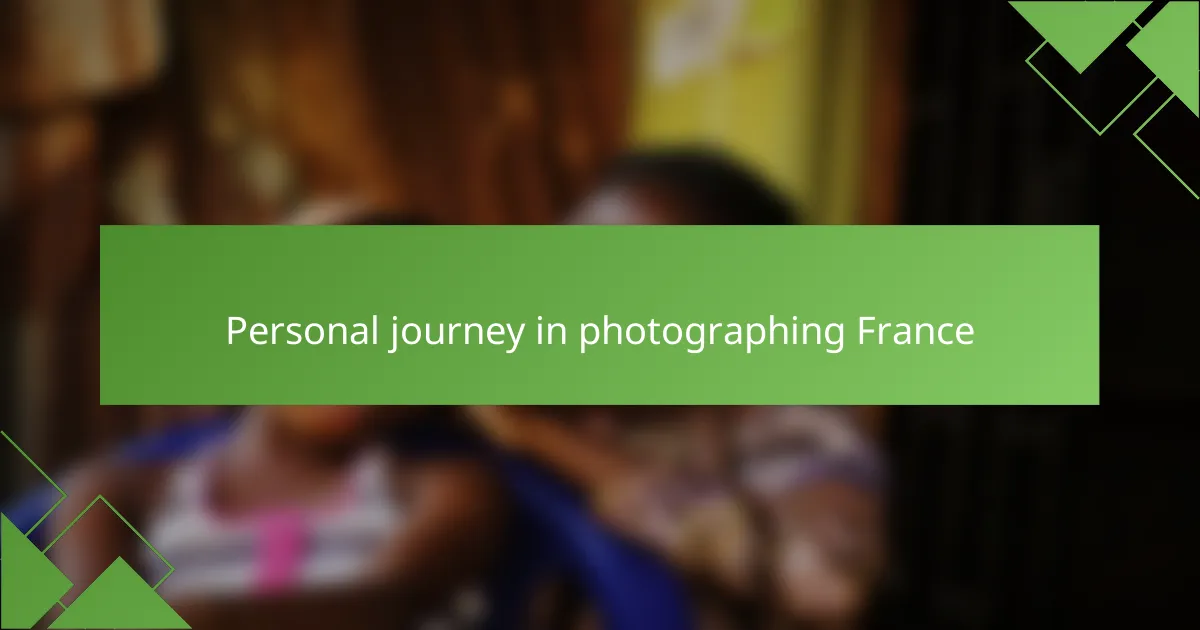
Personal journey in photographing France
Exploring France through my lens has been a captivating journey. My first encounter with French architecture occurred during a summer in Paris, where the intricate details of the Notre-Dame Cathedral left me awestruck. I vividly remember standing beneath its towering spires, feeling a mix of reverence and excitement as I tried to capture the perfect shot—every angle revealed a new story.
As I continued my exploration beyond Paris, I came across the charming, pastel-colored houses of Provence. Each photograph became a piece of the adventure, evoking memories of sun-drenched afternoons wandering through villages. I found that the essence of French architecture is not merely in the structures but in the emotions they evoke and the stories they tell.
- The grandeur of castles like Château de Chambord challenged me to experiment with perspective and depth.
- In the village of Étretat, the cliffs offered a dramatic backdrop, inspiring me to capture nature intertwined with human craftsmanship.
- My visit to a quaint café in Lyon highlighted how architecture serves as a setting for daily life, making it vital to include the people who inhabit these spaces in my images.